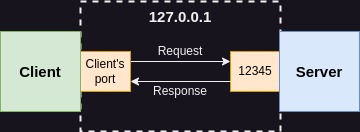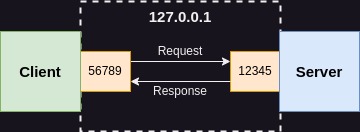Welcome to the next pikoTutorial!
The minimal UDP server
A UDP server listens for incoming datagrams on a specified port and processes them as they arrive.
from socket import socket, AF_INET, SOCK_DGRAM from argparse import ArgumentParser # define command line interface parser = ArgumentParser() parser.add_argument('-ip', help='IP') parser.add_argument('-server_port', type=int, help='Server port') # parse command line options args = parser.parse_args() # create a UDP socket with socket(AF_INET, SOCK_DGRAM) as server_socket: # bind server with a specific network address # which consists of IP and port number server_socket.bind((args.ip, args.server_port)) print(f'UDP server up and listening on {args.ip}:{args.server_port}') # wait for the incoming data data, client_address = server_socket.recvfrom(1024) print(f'Received message from {client_address[0]}:{client_address[1]} : {data.decode()}') # send response to client server_socket.sendto('Message received'.encode(), client_address)The minimal UDP client
A UDP client sends datagrams to a server and optionally receives responses.
from socket import socket, AF_INET, SOCK_DGRAM from argparse import ArgumentParser # define command line interface parser = ArgumentParser() parser.add_argument('-ip', help='IP') parser.add_argument('-server_port', type=int, help='Server port') # parse command line options args = parser.parse_args() # create a UDP socket with socket(AF_INET, SOCK_DGRAM) as client_socket: # send message to server print(f'Sending message to {args.ip}:{args.server_port}') client_socket.sendto('Hello from UDP client!'.encode(), (args.ip, args.server_port)) # receive response from server data, server_address = client_socket.recvfrom(1024) print(f'Received response from {server_address[0]}:{server_address[1] }: {data.decode()}')Bidirectional communication
You can now create the following setup:

Note for beginners: on the image above, I didn’t put any specific number of the client’s port because in the first example that number is assigned by operating system at random. If you want to know how to specify the client’s port as well, you’ll find it in the second example.
Run server with the command below:
python3 server.py -ip 127.0.0.1 -server_port 12345And the client:
python3 client.py -ip 127.0.0.1 -server_port 12345You’ll see the following output in the server’s console:
UDP server up and listening on 127.0.0.1:12345 Received message from 127.0.0.1:36433 : Hello from UDP client!And in the client script output you’ll see:
Sending message to 127.0.0.1:12345 Received response from 127.0.0.1:12345: Message receivedSpecifying client’s port
In the previous example, although we defined the server port, the client’s port was randomly assigned by the operating system. If you need to specify the client’s port, you can bind it manually before connecting to the server:
from socket import socket, AF_INET, SOCK_DGRAM from argparse import ArgumentParser # define command line interface parser = ArgumentParser() parser.add_argument('-ip', help='IP') parser.add_argument('-server_port', type=int, help='Server port') parser.add_argument('-client_port', type=int, help='Client port') # parse command line options args = parser.parse_args() # create a UDP socket with socket(AF_INET, SOCK_DGRAM) as client_socket: # bind client to the specific address client_socket.bind((args.ip, args.client_port)) # send message to server print(f'Sending message to {args.ip}:{args.server_port}') client_socket.sendto('Hello from UDP client!'.encode(), (args.ip, args.server_port)) # receive response from server data, server_address = client_socket.recvfrom(1024) print(f'Received response from {server_address[0]}:{server_address[1] }: {data.decode()}')If you run the above script with the following command:
python3 client.py -ip 127.0.0.1 -server_port 12345 -client_port 56789You’ll get the connection as presented on the image below:

You’ll also see the client’s port number in the server’s logs:
UDP server up and listening on 127.0.0.1:12345 Connection established with 127.0.0.1:56789 Received message: Hello from UDP client!







